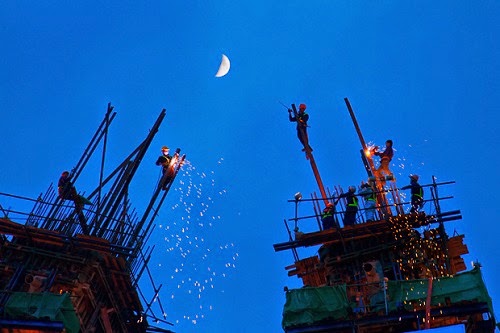
For formal
ceremonies men would have two additional items, a long gown with slits
on either side, and a turban, usually in black or brown made of cotton
or silk. In feudal times, there were strict dress codes. Ordinary people
were not allowed to wear clothes with dyes other than black, brown or
white. Costumes in yellow were reserved for the King. Those in purple
and red were reserved for high ranking court officials, while dresses in
blue were exclusively worn by petty court officials. Men's dress has
gradually changed along with social development.
The traditional set of a long gown and turban gave way to more modern looking suits, while business shirts and trousers have replaced traditional long sleeved shirts and wide trousers. Traditional costumes still exist and efforts are increasingly being made to restore traditional festivals and entertainment which incorporate traditional costumes.
Young women wear light brown-colored short shirts with long black skirts. Their headgear consists of a black turban with a peak at the front. To make their waist look smaller, they tightly fasten a long piece of pink or violet cloth.On formal occasions, they wear a special three layered dress called an "ao dai", a long gown with slits on either side.
The traditional set of a long gown and turban gave way to more modern looking suits, while business shirts and trousers have replaced traditional long sleeved shirts and wide trousers. Traditional costumes still exist and efforts are increasingly being made to restore traditional festivals and entertainment which incorporate traditional costumes.
Young women wear light brown-colored short shirts with long black skirts. Their headgear consists of a black turban with a peak at the front. To make their waist look smaller, they tightly fasten a long piece of pink or violet cloth.On formal occasions, they wear a special three layered dress called an "ao dai", a long gown with slits on either side.

The outer garment is a special silk gown called an "ao tu than"
which is brown or light brown in colour with four slits divided equally
on its lower section. The second layer is a gown in a light yellow
colour and the third layer is a pink gown. When a woman wears her three
gowns, she fastens the buttons on the side, and leave those on the chest
unfastened so that it forms a shaped collar. This allows her to show
the different colors on the upper part of the three gowns. Beneath the
three gowns is a bright red brassiere which is left exposed to cover the
woman's neck.
Over time, the traditional "ao dai" has gone through certain changes. Long gowns are now carefully tailored to fit the body of a Vietnamese woman. The two long slits along the side allow the gown to have two free floating panels in the front and at the back of the dress. The floating panels expose a long pair of white silk trousers.
An elegant looking conical palm hat, which is traditionally known as a "non bai tho" (a hat with poetry written on it), is worn as part of a woman's formal dress. This traditional conical hat is particularly suitable for a tropical country such as Viet Nam, where fierce sunshine and hard rain are commonplace.
Over time, the traditional "ao dai" has gone through certain changes. Long gowns are now carefully tailored to fit the body of a Vietnamese woman. The two long slits along the side allow the gown to have two free floating panels in the front and at the back of the dress. The floating panels expose a long pair of white silk trousers.
An elegant looking conical palm hat, which is traditionally known as a "non bai tho" (a hat with poetry written on it), is worn as part of a woman's formal dress. This traditional conical hat is particularly suitable for a tropical country such as Viet Nam, where fierce sunshine and hard rain are commonplace.

To make a conical
hat, a hat maker chooses young palm leaves that have been been dried
under continued sunshine. Attached beneath the almost transparent layers
of dried palm leaves is a drawing of a small river wharf. Below the
drawing, there is a piece of poetry to be recited by the hat wearer.
In recent years some foreign fashions have been introduced to Viet Nam; however, the traditional "ao dai" remains preferable to women in both urban and rural settings.
In general, Vietnamese clothing is very diverse. Every ethnic group in Viet Nam has its own style of clothing. Festivals are the occasion for all to wear their favorite clothes. Over thousands of years, the traditional clothing of all ethnic groups in Viet Nam has changed, but each ethnic group has separately maintained their own characteristics.
In recent years some foreign fashions have been introduced to Viet Nam; however, the traditional "ao dai" remains preferable to women in both urban and rural settings.
In general, Vietnamese clothing is very diverse. Every ethnic group in Viet Nam has its own style of clothing. Festivals are the occasion for all to wear their favorite clothes. Over thousands of years, the traditional clothing of all ethnic groups in Viet Nam has changed, but each ethnic group has separately maintained their own characteristics.

In the mountain
areas, people live in houses built on stilts, wear trousers or skirts
and indigo vests with design motifs imitating wild flowers and beasts.
In the northern uplands and the Central Highlands, the young women have
made skirts and vests with beautiful and coulourful decoration in a
style convenient for farm work in terraced fields and to travel on hilly
slopes and mountain gorges.
Source: http://www.vietnamtourism.com














.jpg)




